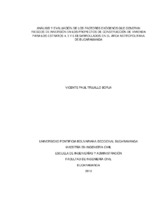Mostrar el registro sencillo del ítem
Análisis y evaluación de los factores exógenos que generan riesgos de inversión en los proyectos de construcción de vivienda para los estratos 4, 5 y 6 desarrollados en el área metropolitana de Bucaramanga
| dc.contributor.advisor | Barón Páez, Leonardo | |
| dc.contributor.author | Trujillo Borja, Vicente Paul | |
| dc.coverage.temporal | 2018 | |
| dc.date.accessioned | 2020-07-13T14:50:17Z | |
| dc.date.available | 2020-07-13T14:50:17Z | |
| dc.date.issued | 2018 | |
| dc.identifier.uri | http://hdl.handle.net/20.500.11912/5712 | |
| dc.description | 85 páginas | spa |
| dc.description.abstract | Esta investigación de tesis de maestría plantea la identificación, clasificación y análisis de las variables de carácter exógeno que afectan la rentabilidad de los proyectos de infraestructura de vivienda ejecutados en los estratos 4, 5 y 6 del Área Metropolitana de Bucaramanga, entre los años 2009 y 2017, factores que se convierten en riesgos que deberían ser evaluados por las empresas que invierten en este tipo de proyectos, más aún cuando dentro de este trabajo se demostró que existe concentración de mercado en el sector, para ello, se desarrolló una metodología que a través de una matriz de frecuencia y una adaptación del análisis de tipo PESTEL permiten la identificación y clasificación de las variables propuestas por los diferentes autores, este procedimiento permite realizar una conciliación de los diferentes criterios, su importancia radica en que se elimina la discrecionalidad al momento de seleccionar, en función a que la cantidad mínima de coincidencias no es un hecho subjetivo, está enfocado en el promedio y la desviación estándar del total de variables mencionadas por los autores. De otra parte, para establecer la importancia de cada factor se utilizó el modelo de regresión lineal múltiple con la metodología de mínimos cuadrados ordinarios. La ecuación obtenida como resultado de este trabajo, detalla cuales son las variables de carácter exógeno que se deben considerar al momento de plantear un proyecto de vivienda en los estratos 4, 5 y 6, además permite establecer la significatividad de las variables, por lo que se convierte en una poderosa herramienta de evaluación de riesgos a los que se exponen este tipo de proyectos en la ciudad. Este enfoque no ha sido desarrollado aún dentro de la gerencia de construcciones, pudiendo considerarse la presente exposición como un inicio en la investigación de este tema a través de la metodología propuesta. | spa |
| dc.description.abstract | This master thesis research proposes the identification, classification and analysis of exogenous variables that affect the profitability (units sold) of housing infrastructure projects executed in stratums 4, 5 and 6 of the Metropolitan Area of Bucaramanga, between years 2009 and 2017, factors that become risks that should be evaluated by both public and private companies that invest in this type of project, especially when within this work it was demonstrated that there is market concentration in the sector, therefore, a methodology has been developed that, through a frequency matrix and an adaptation of the PESTEL type analysis, allow the identification and classification of the variables proposed by the different authors, this procedure allows to reconcile the different criteria, its importance is that discretion is eliminated when selecting, based on the fact that the minimum number of coincidences is not a subjective fact, it is focused on the average and the standard deviation of the total of variables mentioned by the authors. On the other hand, statistical processes such as the multiple linear regression model with the ordinary least squares methodology were used to establish the importance of each factor. The equation obtained as a result of this research work, details which are the variables of exogenous nature that should be considered at the time of proposing a housing project in stratums 4, 5 and 6, in addition, it establishes the significance of the variables, for which becomes a powerful tool when assessing the risks to which this type of project is exposed in the city. This approach has not yet been developed within the field of building management, and this exhibition can be considered as the beginning in the research of this subject through the proposed methodology. | eng |
| dc.format.mimetype | application/pdf | |
| dc.language.iso | spa | |
| dc.publisher | Universidad Pontificia Bolivariana | spa |
| dc.rights | Attribution-NonCommercial-NoDerivatives 4.0 International | * |
| dc.rights.uri | http://creativecommons.org/licenses/by-nc-nd/4.0/ | * |
| dc.title | Análisis y evaluación de los factores exógenos que generan riesgos de inversión en los proyectos de construcción de vivienda para los estratos 4, 5 y 6 desarrollados en el área metropolitana de Bucaramanga | spa |
| dc.type | Tesis de Maestría | spa |
| dc.publisher.department | Escuela de Ingenierías | spa |
| dc.publisher.program | Ingeniería Civil | spa |
| dc.type.hasVersion | publishedVersion | spa |
| dc.description.sectional | Bucaramanga | spa |
| dc.description.degreename | Magíster en Ingeniería Civil | spa |
Ficheros en el ítem
Este ítem aparece en la(s) siguiente(s) colección(ones)
-
Tesis de especialización, maestría y doctorado [1857]
Tesis de especialización, maestría y doctorado


